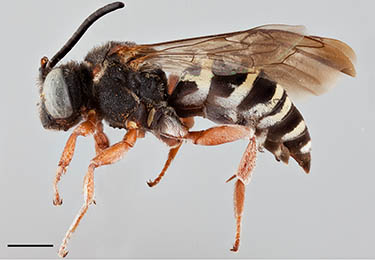Two new species of Epeolini from northern Chile, with the first record of Triepeolus for the country and a key to Chilean species of Doeringiella (Hymenoptera: Apidae)
DOI:
https://doi.org/10.17161/jom.v0i64.5775Keywords:
Apoidea, Anthophila, Apidae, Nomadinae, Epeolini, Triepeolus, DoeringiellaAbstract
Triepeolus cecilyae Packer, new species, and Doeringiella mamabee Packer, new species, both from the far north of Chile are described and illustrated. Both are known from single male specimens despite considerable search effort in the area of their provenance. The former species is the first of the genus recorded from Chile. A key to the three species of Doeringiella Holmberg known from Chile is provided. Caupolicana dimidiata Herbst is recorded as a likely host of D. gigas (Spinola).
References
Amundson, R., W. Dietrich, D. Bellugi, S. Ewing, K. Nishiizumi, G. Chong, J. Owen, R. Finkel, A. Heimsath, B. Stewart, & M. Caffee. 2012. Geomorphologic evidence for the last Pliocene onset of hyperaridity in the Atacama Desert. Geological Society of America Bulletin 124(7–8): 1048–1070.
Bershaw, J., C.N. Garzione, P. Higgins, B.J. MacFadden, F. Anaya, & H. Alvarenga. 2009. Spatial–temporal changes in Andean plateau climate and elevation from stable isotopes of mammal teeth. Earth and Planetary Science Letters 289(3–4): 530–538.
Bertoni, A.W., & C. Schrottky. 1910. Beitrag zur Kenntnis der mit Tetralonia verwandten Bienen aus Südamerika. Zoologische Jahrbücher, Abteilung für Systematik, Geographie und Biologie der Tiere 29(5): 563–596.
Claude-Joseph, F. 1926. Recherches biologiques sur les Hyménoptères du Chili (Mellifères). Annales des Sciences Naturelles, 10ème Série, Zoologie 9: 113–268.
Compagnucci, L.A., & A. Roig-Alsina. 2003. Cuatro nuevas especies y análisis filogenético de Doeringiella Holmberg sensu stricto (Hymenoptera, Apidae, Epeolini). In: Melo, G.A.R., & I. Alves dos Santos (Eds.), Apoidea Neotropica: Homenagem aos 90 Anos de Jesus Santiago Moure: 123–133. UNESC [Universidade do Extremo Sul Catarinense]; Criciúma, Brazil; xvi+320 pp.
Holmberg, E.L. 1886. Viajes al Tandil y á La Tinta. Segunda Parte, Zoología [Insectos. I. Himenópteros–Hymenoptera]. Actas de la Academia Nacional de Ciencias en Córdoba 5(4): 137–184.
Houston, J. 2006. Variability of precipitation in the Atacama Desert: Its causes and hydrological impact. International Journal of Climatology 26(15): 2181–2198.
Michener, C.D. 2007. The Bees of the World [2nd Edition]. Johns Hopkins University Press; Baltimore, MD; xvi+[i]+953 pp., +20 pls.
Michener, C.D., W.E. LaBerge, & J.S. Moure. 1955. Some South American Eucerini bees. Dusenia 6(6): 213–230.
Minvielle, M., & R.D. Garreaud. 2011. Projecting rainfall changes over the South American Altiplano. Journal of Climate 24(17): 4577–4583.
Montalva, J., & L. Ruz. 2010. Actualización de la lista sistemática de las abejas chilenas (Hymenoptera: Apoidea). Revista Chilena de Entomología 35: 15–52.
Morales, M.S., D.A. Christie, R. Villalba, J. Argollo, J. Pacajes, J.S. Silva, C.A. Alvarez, J.C. Llancabure, & C.C. Soliz Gamboa. 2012. Precipitation changes in the South American Altiplano since 1300 AD reconstructed by tree-rings. Climate of the Past 8(2): 653–666.
Moure, J.S. 1955. Notas sôbre Epeolini sulamericanos (Hymenopt.–Apoidea). Dusenia 6(3–4): 115–138.
Mujica, M.I., C. Latorre, A. Maldonado, L. González-Silvestre, R. Pinto, R. de Pol-Holz, & C.M. Santoro. 2015. Late Quaternary climate change, relict populations and present-day refugia in the northern Atacama Desert: A case study from Quebrad La Higuera (18°S). Journal of Biogeography 42(1): 76–88.
Packer, L., & S. Dumesh. 2012. Mirnapis ohloweni Packer and Dumesh, new species with notes on M. inca Urban (Hymenoptera: Apidae: Eucerini). Zootaxa 3478: 113–122.
Robertson, C. 1901. Some new or little-known bees. Canadian Entomologist 33(8): 229–231.
Rightmyer, M.G. 2004. Phylogeny and classification of the parasitic bee tribe Epeolini (Hymenoptera: Apidae, Nomadinae). Scientific Papers, Natural History Museum, the University of Kansas 33: 1–51.
Rightmyer, M.G. 2008. A review of the cleptoparasitic bee genus Triepeolus (Hymenoptera: Apidae). — part I. Zootaxa 1710: 1–170.
Roig-Alsina, A. 1989. A revision of the bee genus Doeringiella (Hymenoptera, Anthophoridae, Nomadinae). University of Kansas Science Bulletin 53(10): 576–621.
Sheffield, C.S., A. Pindar, L. Packer, & P.G. Kevan. 2013. The potential of cleptoparasitic bees as indicator taxa for assessing bee communities. Apidologie 44(5): 501–510.
Thibeault, J., A. Seth, & G.-L. Wang. 2012. Mechanisms of summertime precipitation variability in the Bolivian Altiplano: Present and future. International Journal of Climatology 32(13): 2033–2041.
Vivallo, F. 2009. Notes on the bee genus Alloscirtetica Holmberg, 1909, in northern Chile with the description of two new altiplanic species and a key for the Chilean species of Eucerini (Hymenoptera: Apidae). Zootaxa 2010: 16–30.
Downloads
Additional Files
Published
Issue
Section
License
Copyright for articles published in Journal of Melittology is retained by the authors, with first publication rights granted to the journal. By virtue of their appearance in this open access journal, articles are free to use, with proper attribution and permission of the authors, in educational and other non-commercial settings.





